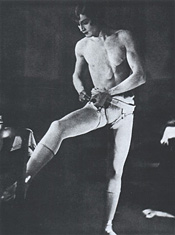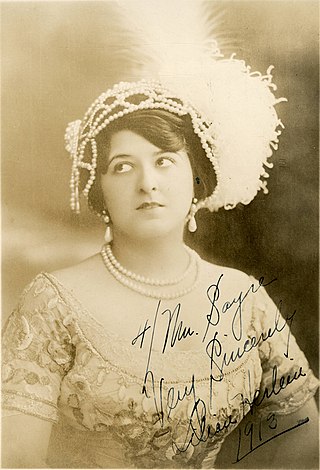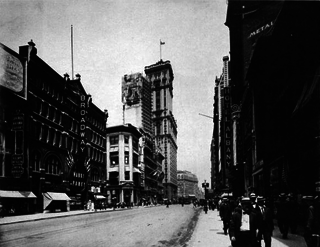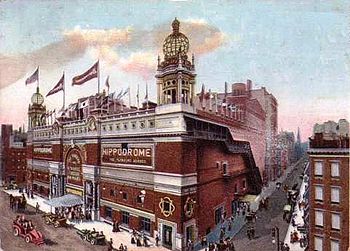
Billy Rose was an American impresario, theatrical showman, lyricist and columnist. For years both before and after World War II, Billy Rose was a major force in entertainment, with shows such as Billy Rose's Crazy Quilt (1931), Jumbo (1935), Billy Rose's Aquacade (1937), and Carmen Jones (1943). As a lyricist, he is credited with many songs, notably "Don't Bring Lulu" (1925), "Tonight You Belong To Me" (1926), "Me and My Shadow" (1927), "More Than You Know" (1929), "Without a Song" (1929), "It Happened in Monterrey" (1930), and "It's Only a Paper Moon" (1933).

Jumbo is a musical produced by Billy Rose, with music and lyrics by Richard Rodgers and Lorenz Hart and book by Ben Hecht and Charles MacArthur.

The Palace Theatre is a Broadway theater at 1564 Broadway, facing Times Square, in the Midtown Manhattan neighborhood of New York City. Designed by Milwaukee architects Kirchhoff & Rose, the theater was funded by Martin Beck and opened in 1913. From its opening to about 1929, the Palace was considered among vaudeville performers as the flagship of Benjamin Franklin Keith and Edward Franklin Albee II's organization. The theater had 1,743 seats across three levels as of 2018.

Fred Andrew Stone was an American actor. Stone began his career as a performer in circuses and minstrel shows, went on to act in vaudeville, and became a star on Broadway and in feature films, which earned him a star on the Hollywood Walk of Fame.

Charles Bancroft Dillingham was an American theatre manager and producer of over 200 Broadway shows.

The Lunt-Fontanne Theatre, originally the Globe Theatre, is a Broadway theater at 205 West 46th Street in the Theater District of Midtown Manhattan in New York City. Opened in 1910, the Lunt-Fontanne Theatre was designed by Carrère and Hastings in the Beaux-Arts style for Charles Dillingham. The theater is named after theatrical couple Alfred Lunt and Lynn Fontanne; its original name was inspired by that of the Globe Theatre, London's Shakespearean playhouse. The current configuration of the interior, dating to 1958, has about 1,505 seats across two levels and is operated by the Nederlander Organization. The facade is a New York City landmark.

Billy Rose's Jumbo is a 1962 American musical film released by Metro-Goldwyn-Mayer and starring Doris Day, Stephen Boyd, Jimmy Durante, and Martha Raye. An adaptation of the stage musical Jumbo produced by Billy Rose, the film was directed by Charles Walters, written by Sidney Sheldon, and featured Busby Berkeley's choreography. It was nominated for an Academy Award for the adaptation of its Rodgers and Hart score.

Niblo's Garden was a theater on Broadway and Crosby Street, near Prince Street, in SoHo, Manhattan, New York City. It was established in 1823 as "Columbia Garden" which in 1828 gained the name of the Sans Souci and was later the property of the coffeehouse proprietor and caterer William Niblo. The large theater that evolved in several stages, occupying more and more of the pleasure ground, was twice burned and rebuilt. On September 12, 1866, Niblo's saw the premiere of The Black Crook, considered to be the first piece of musical theater that conforms to the modern notion of a "book musical".

Vander Clyde Broadway, stage name Barbette, was an American female impersonator, high-wire performer, and trapeze artist born in Texas. Barbette attained great popularity throughout the United States but his greatest fame came in Europe and especially Paris, in the 1920s and 1930s.

Lillian Herlein was an actress and singer in theater and vaudeville in the early 20th century. In vaudeville, she was sometimes known more for display of her figure than for the quality of her performances.

The Fifth Avenue Theatre was a Broadway theatre in Manhattan, New York City, United States, at 31 West 28th Street and Broadway. It was demolished in 1939.

The Liberty Theatre is a former Broadway theater at 234 West 42nd Street in the Theater District of Midtown Manhattan in New York City. Opened in 1904, the theater was designed by Herts & Tallant and built for Klaw and Erlanger, the partnership of theatrical producers Marc Klaw and A. L. Erlanger. The theater has been used as an event venue since 2011 and is part of an entertainment and retail complex developed by Forest City Ratner. The theater is owned by the city and state governments of New York and leased to New 42nd Street. Brookfield Asset Management, which acquired Forest City in 2018, subleases the venue from New 42nd Street.

Robert Hubber Thorne Burnside was an American actor, director, producer, composer, and playwright. He was artistic director of the 5,200-seat New York Hippodrome from 1908 to 1923. He wrote and staged hundreds of dramas, musicals and theatrical spectacles.

The Yiddish Theatre District, also called the Jewish Rialto and the Yiddish Realto, was the center of New York City's Yiddish theatre scene in the early 20th century. It was located primarily on Second Avenue, though it extended to Avenue B, between Houston Street and East 14th Street in the East Village in Manhattan. The District hosted performances in Yiddish of Jewish, Shakespearean, classic, and original plays, comedies, operettas, and dramas, as well as vaudeville, burlesque, and musical shows.

John Lionel Golden was an American actor, songwriter, author, and theatrical producer. As a songwriter, he is best-known as lyricist for "Poor Butterfly" (1916). He produced many Broadway shows and four films.

The Broadway Theatre near 41st Street was a Manhattan theatre in operation from 1888 to 1929. It was located at 1445 Broadway.

Good Times was a popular 1920 Broadway musical extravaganza, with music by Raymond Hubbell and a book by R. H. Burnside. Produced by Charles Dillingham, it debuted on August 9, 1920 at the Hippodrome in New York City and ran for 456 performances, the longest run for the 1920–21 season. It was sixth of Dillingham's elaborate spectacles at the Hippodrome.

Isidro Marcelino Orbés Casanova, best known simply as Marceline, was a world-renowned clown during the late 19th and early 20th century.

Patricia Bowman was an American ballerina, ballroom dancer, musical theatre actress, television personality, and dance teacher.
A Yankee Circus on Mars is a musical in two scenes with music by Manuel Klein and Jean Schwartz, lyrics by Harry Williams, and a book by George V. Hobart. It was one of four works presented together for the grand opening of Broadway's New York Hippodrome; the others being a collection of circus acts known as Circus Tournament, the ballet Dance of the Hours, and the war drama The Raiders by playwright Carroll Fleming. These four works were performed together for the Hippodrome's first public performance on April 12, 1905. Produced by Frederic W. Thompson and Elmer S. Dundy, A Yankee Circus on Mars continued to play together with these other works at the Hippodrome for 296 performances; closing on December 9, 1905. These works then toured the United States together; beginning a national tour in Chicago in February 1906.






















